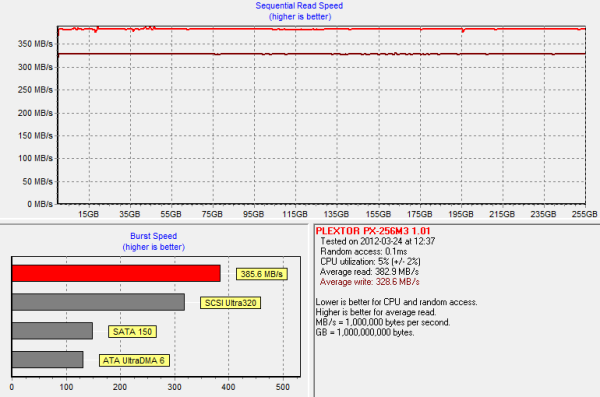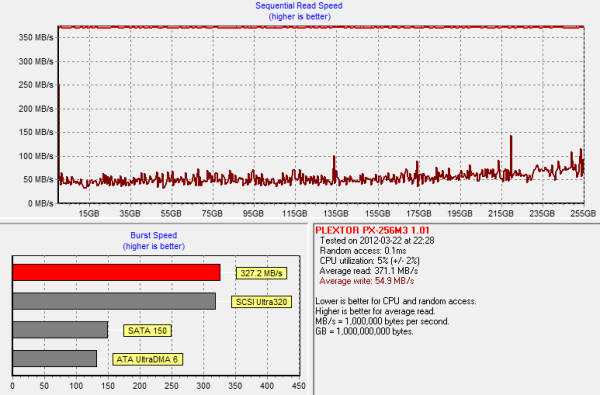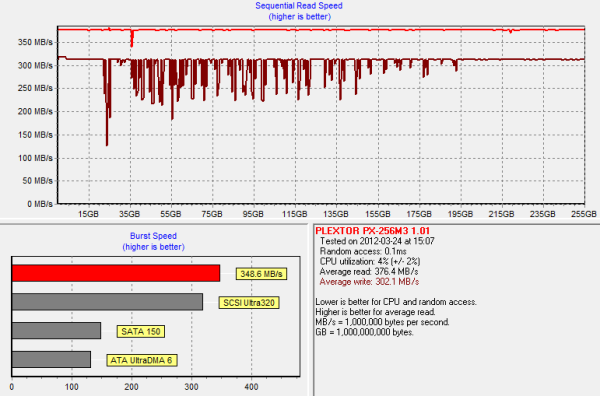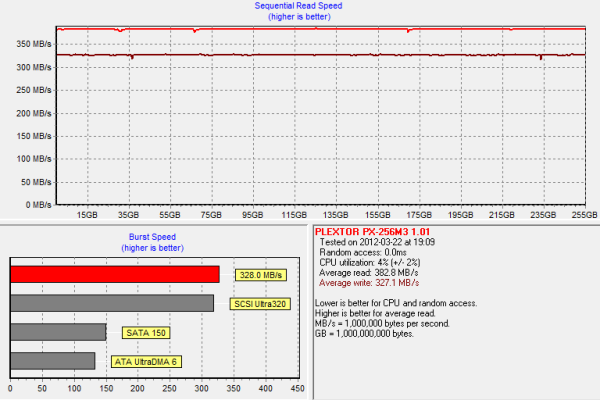The Plextor M3 (256GB) Review
by Kristian Vättö on April 5, 2012 3:05 AM ESTPerformance Over Time and TRIM
When Plextor sent the drive in for review, they emphazised one thing: a technology they call "True Speed". Supposedly, its job is to guarantee a high performance experience throughout the lifetime of the drive, and even when the drive is at a dirty state. As this technology is firmware related, we don't know how it differs from what others (e.g. Intel and Crucial) have done.
First, lets get the base performance by running HD Tach on a clean drive:
In a clean state, we get 383MB/s read speeds and 329MB/s write speeds. Next we ran the drive through our torture test, which consists of 20 minutes of 4KB random writes (QD=32, 100% LBA space) run on a full drive:
The M3 is still able to manage an average write speed of ~163MB/s. However, the write speed drops to as low as 50MB/s for the first LBAs, while the peak performance is still easily over 300MB/s. Plextor does noticeably better than Crucial in this regard as the performance of the m4 dropped to an average of 35MB/s. However, it should also be noted that the M3 had a higher write speed to begin with.
I wasn't ready to let Plextor go this easily. To see how the "True Speed" technology really works, I secure erased the drive, filled it with sequential data and then tripled the amount of 4KB random writes to 60 minutes:
The amplitude of the graph is a lot smaller now and there are only two small peaks, compared to the previous graph with dozens of peaks. The performance drop is significant as we are looking at 50MB/s on average regardless of the LBA. At the lowest, the performance is 35-40MB/s. That's still better than the Crucial m4, however, even with three times the random data thrown at the M4.
Next I secure erased the drive, reran our 20 minute torture test and let the drive idle for 40 minutes:
It does recover pretty well and we are looking at almost as new performance. There are a few negative peaks where the write speed drops to ~130MB/s, but on average the performance is only 25MB/s short of clean performance.
Finally I formatted the drive to see how it responds to the ATA TRIM command:
And the performance is back to brand new.
These graphs show us that if you are running an operating system with TRIM support (e.g. Windows 7), then there is absolutely no problem with the Plextor M3. If you are running an OS with no official TRIM support for the SSD (e.g. Mac OS X), then a SandForce based SSD will still be a better choice in this regard. However, what I would like to note is that our torture test reflects an extreme usage case.
Even if you are an enthusiast or professional, it's unlikely that your usage model will put the drive in a similar state as our torture test. Our torture test is continuously writing 4KB random data across the drive; in the real world there is almost always some sequential data and idle time in between. As shown in the garbage collection graph, the M3 does not need hours of idle time to restore its performance, so it should maintain its performance pretty well even under an OS with no TRIM.















113 Comments
View All Comments
jwilliams4200 - Thursday, April 5, 2012 - link
And still you are avoiding the issue, which is your reviews have been stating that Sandforce SSDs have better steady-state performance than other SSDs like the Plextor M3, when you have no objective test results to back up such statements.I provided links to two other reviews that showed that the Plextor M3 has substantially better steady-state performance than several Sandforce SSDs. Those reviews (mostly) used the recommendations in the industry standard SNIA SSD test protocols.
All you have is arbitrary measurements, and NOT EVEN THE SAME TESTS RUN ON the Plextor M3 and Sandforce SSDs, and you make the claim that Sandforce is better. That is really not at all credible.
Such misleading states are doing an injustice to your loyal readers. Please do the right thing and correct your misleading claims about the relative steady-state performance of Sandforce SSDs, and also start work on developing an objective, consistently-applied steady-state test for future reviews.
Anand Lal Shimpi - Thursday, April 5, 2012 - link
Neither of the reviews you linked to provided steady state data for client workloads.Keep in mind that we run a ton of data internally that shapes our conclusions.
Here's a chart of high queue depth, steady state performance (sequential precondition, 4KB random write QD32):
http://images.anandtech.com/graphs/graph5719/45462...
The precondition is with incompressible data (iometer 1.1.0-rc1, fully random data pattern) as is the 4KB random write pass.
I'm not sure how others measure steady state random write but most controllers, with standard 7% spare area, fall off significantly after being exposed to random writes for an extended period of time.
Take care,
Anand
jwilliams4200 - Saturday, April 7, 2012 - link
The reviews I linked to follow the industry-standard SNIA guidelines for measuring steady-state performance, at least, an abbreviated version of the guidelines.In contrast to anandtech.com, which has completely arbitrary non-random workloads, in violation of the SNIA guidelines. Even worse, anandtech.com runs different tests on Sandforce SSDs than on non-Sandforce SSDs, and then claims that one SSD is better than another based on the results of different tests!
That is highly misleading and doing an injustic to your readers. anandtech.com really needs to do the right thing here.
rw1986 - Friday, April 6, 2012 - link
Jwilliams -- can you offer any supporting evidence to your claim that the Everest 2 is a "rebadged Marvell 88SS9187"? You mention this in several threads but you have not offered any evidence to support that notion...why should we believe you?jwilliams4200 - Thursday, April 5, 2012 - link
For those who are not familiar with the SNIA SSD testing protocols and specifications:http://www.snia.org/tech_activities/standards/curr...
http://www.snia.org/forums/sssi/pts
kyuu - Friday, April 6, 2012 - link
Yeah, we get it. Thanks.Myself, I think that Anand's finding on low write amplification on the Sandforce drives after long-term, real-world usage is more important, and more relevant, than some arbitrary and artificial benchmark standard. Just because some organization says such and such doesn't mean that any alternative is automatically bunk, or that reviewers aren't credible if they don't follow their procedures to the tee.
jwilliams4200 - Saturday, April 7, 2012 - link
Actually, it does mean that reviews are not credible if they don't follow the appropriate SNIA SSS guidelines. The SNIA SSS test specifications were developed by contributors from more than 20 companies in the industry and were carefully reviewed and compiled to form an objective standard for characterization of the performance of solid state storage devices.The reviews from anandtech are not credible at all, because they do not follow any objective standards at all, let alone the SNIA SSS protocols. Anand even admitted that they do not even run the exact same tests on all SSDs. This makes the results completely arbitrary and unreliable.
LokutusofBorg - Saturday, April 7, 2012 - link
You're a walking, talking example of logical fallacies. And you lost all credibility when you claimed the Vertex 4 is a Marvell controller without proof.Anand has been setting the bar for SSD analysis and testing for years now, and you suddenly come into a comments thread and start sounding the warning that his tests are flawed?
The TRIM/torture tests in every review obviously don't try to compare SSDs against each other. All other tests are objective and run the same on each SSD being compared in the graphs. Anand clearly stated this, and you deceptively or ignorantly misinterpreted what he said. Anybody with half a brain reading these comments can see that you need to spend less time typing and more time reading.
jwilliams4200 - Wednesday, April 11, 2012 - link
http://www.anandtech.com/show/5741/ocz-confirms-oc...Bobsy - Thursday, April 5, 2012 - link
Am I glad to see these comments about Plextor being well-known and highly reputable. I remember upgrading my 486 DX2-66 computer with a Plextor optical drive (4X read-only) that I had paid $400. Plextor hardware was leaps and bounds ahead of anything else at the time. The opening comments from the author made me smile and it was obvious that the author was a young person. It is true that we have not heard about Plextor much in quite some time, at least not in terms of their products being the best.